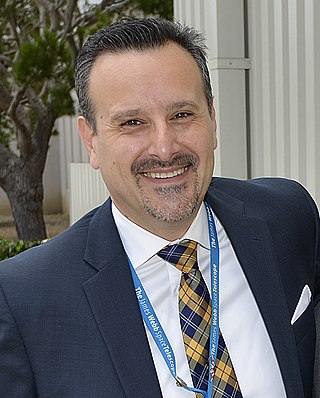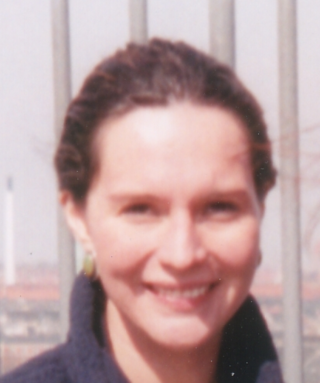
The Royal Astronomical Society (RAS) is a learned society and charity that encourages and promotes the study of astronomy, solar-system science, geophysics and closely related branches of science. Its headquarters are in Burlington House, on Piccadilly in London. The society has over 4,000 members, known as fellows, most of whom are professional researchers or postgraduate students. Around a quarter of Fellows live outside the UK.

The Center for Astrophysics | Harvard & Smithsonian (CfA), previously known as the Harvard–Smithsonian Center for Astrophysics, is an astrophysics research institute jointly operated by the Harvard College Observatory and Smithsonian Astrophysical Observatory. Founded in 1973 and headquartered in Cambridge, Massachusetts, United States, the CfA leads a broad program of research in astronomy, astrophysics, Earth and space sciences, as well as science education. The CfA either leads or participates in the development and operations of more than fifteen ground- and space-based astronomical research observatories across the electromagnetic spectrum, including the forthcoming Giant Magellan Telescope (GMT) and the Chandra X-ray Observatory, one of NASA's Great Observatories.
Solar physics is the branch of astrophysics that specializes in the study of the Sun. It intersects with many disciplines of pure physics and astrophysics.

The Astronomical Observatory of Rome is one of twelve Astronomical Observatories in Italy. The main site of the Observatory is Monte Porzio Catone. Part of the Istituto Nazionale di Astrofisica since 2002.
Doris Daou is a Lebanese-born Canadian-American astronomer who was formerly the Director for Education and Public Outreach of the NASA Lunar Science Institute and the associate director of the NASA Solar System Exploration Research Virtual Institute (SSERVI), and is currently the program contact for NASA's "Small Innovative Missions for Planetary Exploration (SIMPLEx)".
Catharine "Katy" D. Garmany is an astronomer with the National Optical Astronomy Observatory. She holds a B.S. (astrophysics), 1966 from Indiana University Bloomington; and a M.A. (astrophysics), 1968, and Ph.D. (astronomy), 1971, from the University of Virginia. Catharine's main areas of research are massive stars, evolution and formation; astronomical education.

Jean Hebb Swank is an astrophysicist who is best known for her studies of black holes and neutron stars.

Alberto Conti, is an astrophysicist and the Vice President and General Manager of the Civil Space Strategic Business Unit (SBU) at BAE Systems Inc.. He is one of the creators of the GoogleSky concept, of the idea of astronomical outreach at South by SouthWest 2013 and of the James Webb Space Telescope iBook. He is also the Executive Producer of the Emmy Winning CNN Films The Hunt for Planet B.

Dr. Kimberly A. Weaver is an American astrophysics astronomer and professor. She has worked with NASA on several research projects. She is often seen on television programs about astronomy. She is an expert in the area of x-ray astronomy.

Alicia Margarita Soderberg is an American astrophysicist whose research focused on supernovae. She was an assistant professor of astronomy at Harvard University and a postdoctoral fellow at the Harvard-Smithsonian Center for Astrophysics.

Wendy Laurel Freedman is a Canadian-American astronomer, best known for her measurement of the Hubble constant, and as director of the Carnegie Observatories in Pasadena, California, and Las Campanas, Chile. She is now the John & Marion Sullivan University Professor of Astronomy and Astrophysics at the University of Chicago. Her principal research interests are in observational cosmology, focusing on measuring both the current and past expansion rates of the universe, and on understanding if there is missing physics in the standard cosmological model.
Sarah Dodson-Robinson is an American astronomer known for her work on planet formation and an associate professor of physics and astronomy at the University of Delaware.

Beth A. Brown was a NASA astrophysicist with a research focus on X-ray observations of elliptical galaxies and black holes. She earned a Ph.D. in Astronomy from the University of Michigan in 1998, becoming the first African-American woman to do so.

Joan T. Schmelz is the associate director for science and public outreach at the Stratospheric Observatory for Infrared Astronomy (SOFIA) for the Universities Space Research Association (USRA). Previously, Schmelz was the deputy director of Arecibo Observatory and the director of USRA Operations at Arecibo from 2015 through 2018. Before joining USRA, Schmelz was an NSF program director in the Astronomical Sciences Division, where she oversaw the Astronomy & Astrophysics Postdoctoral Fellowship program, and a professor of physics at the University of Memphis from 1996 to 2017. Schmelz's research focus is heliophysics, specifically investigating the coronal heating problem as well as the properties and dynamics of the solar atmosphere. She uses spectroscopic and image data in the X-ray and ultraviolet wavelength ranges obtained from NASA satellites and rockets. She has published over 80 refereed scientific journal articles and authored three books.
Ann Hornschemeier is an American astronomer specializing in X-ray emission from X-ray binary populations. She is the Chief Scientist for the Physics of the Cosmos program at NASA.
Lynn Cominsky is an American astrophysicist and educator. She was the Chair of Astronomy and Physics at Sonoma State University in Rohnert Park, California from August 2004 through August 2019. She is currently the Project Director for the NASA Education and Public Outreach Group.

Kimberly Kowal Arcand is a data visualizer and science communicator for NASA's Chandra X-ray Observatory. She is also the visualization coordinator for the Aesthetics and Astronomy image response project at the Center for Astrophysics | Harvard & Smithsonian located in Cambridge, Massachusetts.

Anne L. Kinney is an American space scientist and educator. Kinney is currently the Deputy Center Director at NASA Goddard Space Flight Center. Previously, she held positions as the head of the Directorate for Mathematical and Physical Sciences (MPS) for the National Science Foundation (NSF), the Chief Scientist of the W.M. Keck Observatory, Director of the Solar System Exploration Division at NASA Goddard Space Flight Center, Director of the Origins Program at NASA Jet Propulsion Laboratory, and Director of the Universe Division at NASA Headquarters. She earned a bachelor's degree in astronomy and physics from the University of Wisconsin-Madison and a doctorate in astrophysics from New York University, and has published more than 80 papers on extragalactic astronomy. She was an instrument scientist for the Faint Object Spectrograph that flew on the Hubble Space Telescope.
Lucy Frear Fortson is an American astronomer known for her work on gamma-ray astronomy and Galaxy morphological classification and for her leadership of citizen science projects including the Galaxy Zoo and Zooniverse. She is a professor in the School of Physics and Astronomy at the University of Minnesota.

Nicole Marie Lloyd-Ronning is an American computational astrophysicist specializing in gamma-ray bursts and the deaths of massive stars as a researcher at the Los Alamos National Laboratory and lecturer at University of New Mexico–Los Alamos. She is also known for her work in science popularization, as the author of the book Great Mysteries in Astrophysics, as a scientist ambassador for the Bradbury Science Museum, and in youth outreach programs, especially for young people from indigenous groups in the American southwest.












